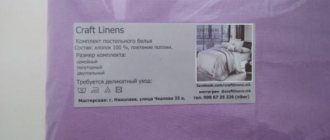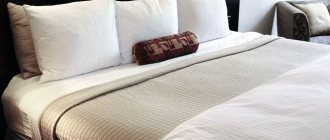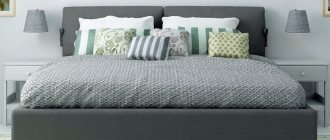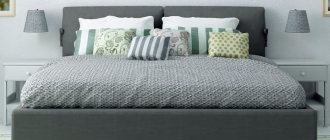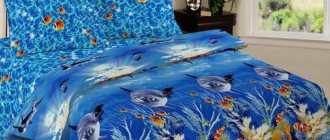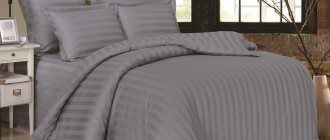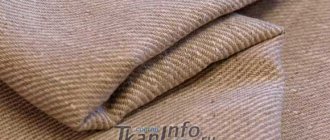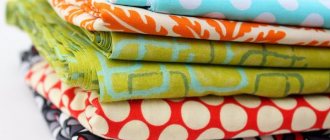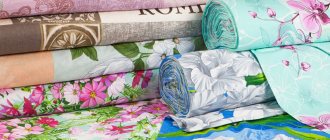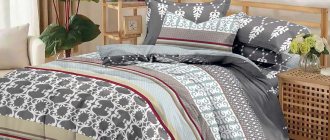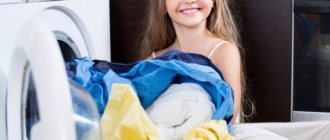The modern rhythm of life often does not give us the slightest opportunity to relax. That is why we can truly relax and gain strength only in our dreams. And, as you know, the quality of our night's rest largely depends on the bedding we choose.
Until recently, the choice of fabric for bed linen was reduced to thin chintz, thick calico and durable plain-dyed linen. Today, the range of materials for sewing sleeping sets is so wide that we know very little about some materials, and even more so we are unlikely to be able to distinguish one from the other.
Our article today will be devoted to two fabrics - satin and percale. Each of them has its own characteristics and advantages, but they have something in common: the raw material from which they are made is cotton.
You will learn the difference between satin and percale, get acquainted with the basic recommendations for caring for these fabrics, and also be able to compare prices for such sets.
Features of percale bed linen
Percale is not a new fabric. This material was first produced in India in the 17th century. In Europe, percale gained particular popularity in France - it was this material that acted as a raw material when sewing bed linen for royalty and courtiers.
Percale is made from a special cotton - long-fiber. The threads are woven together in a special way - the front side of the fabric is soft and smooth, and the back side is dense and durable.
In order to slightly reduce production costs, polyester or polyester is often included in the composition of this fabric (according to generally accepted standards, up to 15% of synthetics in the composition of the material is allowed). Percale containing linen or silk fibers is quite rare - such fabric can hardly be called budget and affordable. Of all the types of percale, cotton is considered the universally recognized classic.
There are household and technical percale:
- The first is used for sewing bed linen, table textiles, and clothing. The second is for the manufacture of tents, awnings, parachutes.
- Technical percale is characterized by a lower thread density compared to household percale, therefore, in order to achieve the required strength indicators, it undergoes special treatment - it is impregnated with special protective compounds.
The wear resistance and durability of percale are due to the use of a special adhesive composition (size) during the production process, which is used to process the threads.
If we talk about the properties and features of percale, we can highlight the following points:
- Strength and increased density.
- The fabric does not allow down or feathers from pillows and blankets to pass through, while it is quite thin, light, soft, smooth and pleasant to the touch.
- Wear resistance. Thanks to special processing and a special weave of threads, percale bed linen will perfectly withstand up to 1000 washes (if, of course, you follow the recommendations for caring for the product).
- Brightness. Percale is great for applying complex prints that do not fade during washing or rub off during use.
- Hypoallergenic and environmentally friendly.
Today, percale bed linen is classified as luxury. Externally, these sets are very reminiscent of silk - smooth, soft, shining. At the same time, percale is much more unpretentious than expensive silk fabrics.
As for the differences from satin, percale, first of all, has a completely different weave - “satin” threads are tightly twisted, due to which the fabric acquires a slight shine and shine. Percale is characterized by a plain weave, and the shine is the result of a special multi-stage processing, which makes the fabric not only beautiful, but also very durable.
Purchasing Tips
Sellers will not always be able to advise which fabric to choose when buying bed linen. We'll give you a few highlights.
Composition and quality
Modern natural fabrics must contain more than 60% natural fibers. They are best suited to human skin due to their characteristics. But not all popular fabrics can withstand intensive use, as synthetic materials do. Bed linen made from natural fibers may contain a small percentage of synthetics, which increases the wear resistance of the linen.
It is not recommended to take underwear made from 100% synthetic materials.
Is fabric density really important?
Fabric density is another main condition for choosing bed linen. The denser the texture of the material, the higher its wear resistance, and vice versa, the lower the density, the worse the material. The density of the fabric is calculated from the number of threads per 1 cm2.
For example, cambric and chintz sets have the lowest density, while linen and satin have the highest density.
Practicality
It is necessary to give preference to fabrics, the care of which will not turn into flour or will not require large financial costs. For example, if you want to sleep on a glossy sheet, you can buy satin. It is cheaper than silk and does not require specialized cleaning.
Chintz or loose calico are well accepted by the skin, but are not able to withstand long-term use.
Size
Bed linen must match the size of the bed and bedding. Larger underwear is inconvenient to tuck in, it slips and gets tangled. Smaller underwear will not cover the sleeping area.
Features of satin bed linen
Satin is a cotton fabric that differs from others in a special weaving method - satin. The front side is formed by highly twisted weft threads, which make it smooth and “sliding” like silk. The reverse is formed from warp threads that do not twist, making the fabric soft and pleasant to the body.
Other fibers are often added to the composition of cotton sateen:
- Polyester
- to reduce the cost of fabric. Naturally, the properties of the material deteriorate. - Silk
- to give the fabric additional shine and gloss. Satin mixed with silk fibers is very expensive, but at the same time incredibly beautiful and high quality. - Linen
- to increase the strength of the material.
When choosing a set of bed linen, pay attention to the composition - it is better not to buy satin with an admixture of synthetics, since such linen is highly electrified, wears out quickly and loses its original appearance after 2-3 washes.
Types of satin:
- Mako-satin.
Fabric made exclusively from cotton. - Novo-satin.
Essentially, it is synthetic with the addition of cotton (10% on average). It is clear that such fabric is highly electrified, very quickly loses its original properties, and fades. At the same time it is quite cheap. - Polysatin.
A mixture of cotton and synthetics in a ratio of 1:1 or 1:3. There is also a completely synthetic satin made of polyester or polyester. - Crepe satin.
Ideally, cotton with the addition of silk fiber is used for its production. This is a very durable, beautiful, pleasant to the touch fabric. Its main drawback is its high cost. - Satin jacquard.
Thanks to the special weave of cotton threads, a textured pattern appears on the surface of the fabric. Satin jacquard material is not cheap. But such a set will last for more than one year. - Satin "luxury".
In essence, this is a standard satin with an increased density of thread weave. The fabric is very dense, durable, beautiful and... expensive.
Main properties of satin:
- Beautiful appearance
- the “glossy” front side makes satin incredibly similar to natural silk. - Strength and durability.
Thanks to special weaving, satin can withstand a large number of washes. However, its appearance remains unchanged. - Wear resistance.
If chintz or calico bed linen becomes thin after just a few months of use, then satin will serve you faithfully for several years. - Hypoallergenic and environmentally friendly.
Cotton sateen is produced without the use of synthetic impregnations, so it does not cause allergic reactions and does not harm the environment.
The main advantages of satin are due to its properties - it is a durable, fairly thin, but dense, wear-resistant fabric. It is worth saying that natural satin (made from natural fibers - cotton, linen, silk - without the use of synthetics) is not cheap.
If you have pets who love to snuggle on your bed, satin is the perfect solution. Wool and dust practically do not stick to this fabric.
Satin made using polyester has certain disadvantages - such fabrics become highly electrified, during use, “pellets” form on them, and the brightness of the linen is lost.
The main difference between satin and percale is the weaving principle. Satin uses satin weave, percale uses linen weave. The shine of percale is the result of chemical treatment of the fabric, and satin shines due to the presence of highly twisted threads in the fabric.
Other types of fabrics
• Linen
Flax has the best properties for human health. Linen fabric is an environmentally friendly, hygienic material. It is especially popular in hot countries, as it is well ventilated. But the main disadvantage of linen products is that they wrinkle and are difficult to smooth out. Sets of underwear with the addition of cotton are designed to solve this problem.
• Bamboo
Bed linen made from bamboo is becoming increasingly common. Bamboo fiber is a natural material with a characteristic shine. This linen is very soft and beautiful, it has a long service life.
• Flannel
Flannel fabric is also soft and very pleasant to the touch. But over time, pellets form on it. But this linen will keep you warm on winter evenings.
• Silk
Silk is considered the most luxurious and expensive bed linen. Natural silk, especially made in Japan, is valued above all else. It shines beautifully and looks very elegant. If you decide to purchase underwear made of artificial silk, then keep in mind that such a set can slip a lot, sleep on it in winter, and in summer it sticks to the body, in addition to this, puffs form on it. The only disadvantage of natural silk is the need for hand washing.
How to choose bedding for a child?
As you already understand, the choice of materials for pastel linen is huge. But we hope that the advice received will help you make your choice, and the purchased underwear will delight you for a long time.
How to distinguish percale from satin?
At first glance, it may seem that satin and percale are almost identical fabrics. However, there is still a difference between them. In order to accurately distinguish percale from satin, pay attention to the following nuances:
- Density.
Percale is a fabric that is denser to the touch. Satin is soft and thin. - Smoothness.
Satin is smooth, even on the front side, even a little “sliding”, more like silk. Percale is velvety. From the inside, both percale and satin are softer than from the “face”. - Shine.
The shine of satin is more pronounced. Percale seems a little matte in comparison.
An important difference between satin and percale is their cost. Satin is usually more expensive (if we are talking about natural fabric). At the same time, percale mixed with silk will also be expensive.
Which fabric is more expensive?
It is difficult to talk about the cost of bedding sets, especially when it comes to retail prices. If we talk about the cost of fabric production, satin is more expensive than percale. However, the cost of finished products can vary greatly, and here's why:
- Polysatin linens are characterized by lower quality, so they are quite cheap - up to 1,600 rubles for a double, up to 2,000 rubles for a Euro set.
- Sets made of “luxury” and mako-satin are the most expensive - up to 20,000 rubles per euro set.
- A double set made of percale will cost from 5,000 to 7,000 rubles, depending on the quality of the fabric.
A custom-made percale double bed linen set will cost you on average from 8,000 to 15,000 rubles.
Which fabric is stronger?
Despite its lower cost, percale is a more durable fabric.
If we consider the wear resistance of these two materials, satin noticeably loses. High-quality percale can easily withstand up to 1000 washes without losing its original properties, and the most expensive satin, at best, can last up to 500. Considering that bed linen is washed on average once a week, with the help of simple calculations we find that a percale set will last you 18-19 years , satin – half as long – 8-9 years. But the question arises: do you plan to use the same underwear for so long?..
What is "synthetics"?
First of all, do not confuse artificial and synthetic fibers used for fabric production. If we simplify a little and don’t go deep into chemistry and materials science, we can say that
- artificial fibers are produced by chemical processing of natural materials (cellulose most often),
- Synthetic fibers are completely produced chemically - they contain chemical raw materials (various polymers) and processing methods.
For the average consumer, this nuance is often difficult to discern - after all, both are “chemistry”. But the fact is that the chemistry of the chemistry is different: artificial fibers (for example, viscose or such as “bamboo”, “Tensel”), being essentially just converted natural cellulose, have many of the properties of natural fibers - they are very similar to cotton and flax also absorbs water, is resistant to heat, but is only more durable. But synthetics are completely man-made, as a result of which their properties are further removed from natural fibers.
What is softer: satin or percale?
The main characteristic of sleeping linen that you should pay attention to when purchasing is its comfort. Both satin and percale are very comfortable and pleasant to the touch fabrics. At the same time, the tactile sensations from touching them are different.
Satin is a smooth, light, silky material, very reminiscent of click. It is good to sleep on it in the summer in the heat - the “glossy” surface of the linen pleasantly “cools”, but at the same time allows air to pass through perfectly. In winter it warms well.
Percale is velvety, yet quite dense.
Compared to percale, satin is much softer.
Which is easier to care for?
Both satin and percale are natural fabrics. However, they require special care to maintain their original qualities:
- Wash at a temperature not exceeding 60 degrees.
- Spin – up to 800 rpm.
- Can be tumble dried in a washer dryer.
- You can iron both from the inside and from the front side. Temperature – 150 degrees. It is advisable to iron slightly damp items.
- It is not advisable to frequently use strong bleaches and stain removers - they negatively affect the fabric fibers and make the color duller.
Satin is a softer material, so it is much easier to smooth out. If you use the “Easy Ironing” mode during washing, you can do without an iron altogether. And during use, satin wrinkles much less than percale.
Sale of bed linen sets
Best prices for bulk purchases
View in the catalog
Which is better?
Poplin is a cotton fabric that is made by weaving threads of different thicknesses: thin threads are the weft, thick threads are the warp. The result is a soft and inexpensive material that is perfect for sewing bedding sets. Despite the obvious similarity between poplin and satin and percale, these fabrics are very different. Features of poplin:
- It's inexpensive.
- Softer than satin and percale.
- Significantly inferior to these two fabrics in strength and density.
- Less durable and wear-resistant than satin and percale.
- Satin is silkier and smoother than poplin.
- Poplin can be washed at temperatures up to 40 degrees, the fabric is easy to iron.
Considering all of the above, with obvious budget restrictions, it is quite possible to buy poplin bed linen. Of course, it won’t last as long, and its appearance won’t be as luxurious, but for the same money you can buy 2 sets at once!
Synthetic fabrics
When the question arises, “Which material is better to choose bedding from,” the thought immediately flashes through your head that it’s definitely not synthetic. There is nothing natural about these fabrics. They are made from polymers synthesized from coal, gas, and oil products. This production method reduces the commodity price of synthetic fabrics with unique and not always beneficial properties for humans. Synthetic fabrics are electrified, poorly ventilated, and do not absorb moisture.
Microfiber
The peculiarity of microfiber is that repeated washings have absolutely no effect on the shades of bed linen or the formation of bald spots. Microfiber is a soft material, easily perceived by the body, and perfectly absorbs moisture.
Microfiber is completely undemanding to care for.
Polycotton
Polycotton is easily confused with calico. The tactile properties of these fabrics are similar to each other, so you should pay attention to the composition of the underwear. Polycotton contains 30-85% polyester - a product of molten oil.
Polycotton retains its properties for a long time. The bright colors in which the material is usually dyed do not wash out. The material does not require ironing.
Comparing calico with percale and satin
Calico is a high-quality, dense, durable fabric. This is an ideal budget material for sewing inexpensive bed linen. The main difference between calico and satin and poplin (from the point of view of production technology) is the use of threads of the same thickness in weaving. At the same time, the thickness of the thread itself is not always even throughout its entire length, which can be very noticeable on the finished product.
Essentially, calico is coarser and looser than satin and percale. But its price is much lower - from 3,000 rubles for a double set.
Percale or satin, which is better to choose?
So, when choosing a set of bed linen, you first need to decide on your personal wishes:
- If a stylish appearance is your priority, don’t hesitate to take satin. Only silk can compare with the gloss and shine of this fabric. Among other things, a huge selection of colors and prints of satin lingerie will not leave anyone indifferent.
- Percale is a more durable fabric. Therefore, if you plan to use the set for a long time, pay attention to this kind of underwear.
- Pay attention to laundry care. Satin is less whimsical and does not wrinkle during use. In addition, percale and calico shrink over time, but satin does not.
- Composition is one of the most important characteristics of bed linen. It is extremely undesirable to buy sets that contain synthetics - they become highly electrified, quickly lose their original appearance, and fade when washed.
- Choose trusted manufacturers. The fact is that Turkish, Pakistani and Chinese factories sew very beautiful and extremely cheap sets of “satin” and “percale”. In fact, it may turn out that the fabric contains 60% synthetics.
| Satin (cotton, without polyester admixtures) | Percale (cotton, without polyester admixtures) | |
| Price | From 15,000 to 20,000 rubles | From 5000 to 7000 rubles |
| Strength | Withstands 300-500 washes | Withstands up to 1000 washes |
| Density | On average 120 – 145 g/m2 | Average 115 g/m² |
| Softness | The material is pleasant to the touch, smooth | The front surface is velvety, there is a slight semi-matte shine |
| Appearance | Looks very stylish and expensive. Externally, satin is very similar to natural silk. Perfect for those who prefer not to cover their bed with a blanket. | Compared to satin, it looks simpler and more restrained. |
| Care | Does not require special care, does not wrinkle during use. | It is advisable to iron percale bed linen slightly damp. Shrinks after washing at high temperatures. |
| Production | During the production process, no chemical compounds are used to impart strength and shine to the threads. | During the production process, a special adhesive is used to make the fabric more durable. |
Reviews about both fabrics are only positive (if we are talking about natural materials, without the weaving of synthetic threads).
Of course, it is quite difficult to compare satin and percale - each of these fabrics has its own advantages and disadvantages, so you need to focus solely on your preferences and financial capabilities.
Nylon, satin or polyester? Choosing textiles for the label!
Not a single modern tailoring enterprise can do without such a small but important detail as a sew-in label. In fact, these kinds of marking elements are nothing more than the familiar thermal transfer labels from price-etiketka.ru, simply made on textiles. In the standard, several fabrics are used as the basis for textile labels. Most printers work with satin, polyester or nylon. Therefore, if a company needs such thermal labels, buying a printer for their production is the right decision. Devices for printing fabric labels are compact, consumables for them can be purchased literally “in one click,” and absolutely anyone can master working with this technique. Let's look at the features of printing labels on a specific type of fabric. Polyester as a base for such a label has long gained popularity among textile industry enterprises. It is famous for its unusually smooth surface, due to which high-quality printing (up to 300 dpi) is possible, and on both sides of the label. Nylon is similar to polyester, but is slightly inferior in surface smoothness. Despite this, this material is the most popular base option for sew-in labels due to its ability to not accumulate static electricity. This is prevented by a special impregnation of the fabric. It also makes the surface of nylon smoother until it resembles paper. price-etiketka.ru In addition, the advantage of these tapes is that, unlike other textile blanks for labels, it is enough to sew them on one side, because even with cold cutting, its edges will not unravel. But satin (or polyester-satin) does not have such impregnation, but this is compensated for by special weaving of the thread. Thanks to it, one side of the material is rough, with a large texture, but the other is glossy and smooth. It is on it that high-quality printing is performed quite well. The main advantages of satin are its simultaneous softness and strength, which is why such labels are often sewn into underwear and clothing that has direct contact with the body. The downside of satin is the need to secure the cut edge, otherwise the threads begin to unravel. Therefore, such labels are either sewn in with a loop or each edge is stitched separately. This is how materials for textile labels are selected. And a properly selected ribbon will help make the image indelible - thermal transfer film from price-etiketka.ru with an ink base. By contacting our company, you will receive high-quality and durable thermal labels. Delivery of ink ribbons throughout Russia: Moscow, Tver, Chelyabinsk, Samara, Izhevsk, Ivanovo, Rostov-on-Don, Tomsk, Cheboksary, Ufa, Krasnodar, Krasnoyarsk, Nizhny Novgorod, Nizhny Tagil, Kurgan, Arkhangelsk, Novosibirsk, Kazan, St. St. Petersburg, Yekaterinburg, Omsk, Perm, Irkutsk, Tambov, Dolgoprudny, Korolev, Volgograd, Dubna, etc. More information about thermal and thermal transfer printing, label printers and consumables can be found on the website price-etiketka.ru. Thermal paper labels come in sizes: 20*30, 30*25, 43*25, 58*30, 58*40, 58*60, 74*45, 75*100, 100*150, 100*72, 70*25.
Information provided by the website Price-Etiketka.ru
